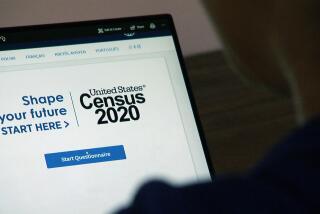Census change may result in fewer ‘white’ Americans

Commuters descend steps from the Staten Island Ferry on their way to work in New York City.
reporting from Albuquerque — The Census Bureau is considering changes to its race and ethnicity questions that would reclassify some minorities who were considered “white” in the past, a move that may speed up the date when America’s white population falls below 50%.
Census Director John Thompson told the Associated Press that the bureau is testing a number of new questions and may combine its race and ethnicity questions into one category for the 2020 census. That would allow respondents to choose multiple races.
The possible changes include allowing Latinos to give more details about their ethnic backgrounds and creating a distinct category for people of Middle Eastern and North African descent.
“We haven’t made any decisions yet,” Thompson said in an interview before his meeting Nov. 17 with Native American leaders in New Mexico. “But I don’t think these new questions would diminish anything. It would just give us more information about our diverse populations.”
William Frey, a demographer for the Brookings Institution’s Metropolitan Policy Program, says the proposed changes would grant residents more freedom to define their races and ethnicities.
“I don’t know if this will make a huge difference in the 2020 census on whites becoming the minority, but it could later,” said Frey, author of “Diversity Explosion: How New Racial Demographics Are Remaking America.”
In the past, “white” was the only racial option available to Arab American respondents, a classification that didn’t truly reflect their social standing and hurt efforts for their political empowerment in post-Sept. 11 America, said Samer Khalaf, president of the American-Arab Anti-Discrimination Committee.
“If you are going to classify me as white, then treat [me] as white,” Khalaf said. “Especially when I go to the airport. So, yeah, it’s inaccurate.”
For years, many U.S. Latinos also checked the “white” box because options were limited, said Lorenzo Cano, associate director of the Center for Mexican American Studies at the University of Houston. But many Latinos are now opting to check “American Indian” to identify with their links to indigenous populations in Latin America.
Overall, “these changes could reduce the number of people who identify as white,” Cano said.
The Census Bureau has estimated that the country’s population will have more minorities than whites for the first time around 2043 or 2044, a result of higher birth rates among Latinos and a stagnating or declining birthrate among blacks, whites and Asians.
How much the changes could speed up the moment when minorities will outnumber whites is anyone’s guess. Analysts would first have to examine the new data — some of which won’t be comparable to 2010 because of the possible new categories, Frey said.
The proposed changes could present a new set of challenges for the Census Bureau. For example, Dee Ann Alexander, a census tribal specialist, said Mexican Americans who check the “American Indian” box could deter efforts to get an accurate count of enrolled tribal members living in cities.
“It’s a concern,” Alexander said. “Around 74% of Native Americans live in urban areas, and it’s a challenge to search for that population.”
In addition, an aggressive push by the census to include Arab Americans in the count might lead to more suspicion because many of them fear the federal government, Khalaf said.
“They think it will put them under surveillance,” he said. “They won’t fill [the census] out because they don’t want to be on any list.”
Still, such new questions could give a more accurate assessment of a changing America at a time when 15% of all marriages involve couples of difference races, Frey said.
“And who knows how their children will identify,” he said.
More to Read
Sign up for Essential California
The most important California stories and recommendations in your inbox every morning.
You may occasionally receive promotional content from the Los Angeles Times.










